Many houseplants produce colorful flowers in yellow, red, purple, and other brilliant shades. If you’re lucky, you can also find an assortment of attractive indoor plants with leaves in unusual colors. Curating a houseplant collection with plants in a single-color family can create an intriguing display that will be the highlight of your home’s décor.

If you love houseplants with patterned leaves, check out our list of houseplants with striped foliage. However, if you adore yellow colors, you’ll find the sunniest yellow plants with golden to bright canary yellow flowers or leaves right here. Celebrate the color yellow and find new plants for your collection in the list below!
Jump to:
- 25 indoor plants with sunny yellow leaves or flowers
- 1. Gerbera Daisy (Gerbera jamesonii)
- 2. Orchids (Orchidaceae spp.)
- 3. Bromeliads (Bromeliaceae spp.)
- 4. Crotons (Codiaeum variegatum)
- 5. Golden Shrimp Plant (Pachystachys lutea)
- 6. Lithops (Lithops spp.)
- 7. Caladiums (Caladium bicolor)
- 8. ‘Widow’s Thrill’ Kalanchoe (Kalanchoe blossfeldiana)
- 9. Snake Plants (Dracaena trifasciata)
- 10. Marble Buttons (Conophytum calculus)
- 11. Golden Pothos (Epipremnum aureum)
- 12. Philodendron 'Aurea' (Philodendron bipennifolium)
- 13. Sweet Potato Vine (Ipomoea batatas)
- 14. Hibiscus (Hibiscus spp.)
- 15. ‘Song of India’ Dracaena (Dracaena reflexa)
- 16. ‘Yellow Fusion’ Calathea (Calathea louisae)
- 17. ‘Prince of Orange’ Philodendron (Philodendron erubescens)
- 18. ‘Nonstop Yellow’ Begonia (Begonia x tuberhybrida)
- 19. Primrose (Primula vulgaris)
- 20. Coleus (Plectranthusscutellarioides)
- 21. Angel Trumpet (Brugmansia spp.)
- 22. Zebra Plant (Aphelandra squarrosa)
- 23. Bush Lily (Clivia minata)
- 24. Prickly Pear (Opuntia spp.)
- 25. ‘Yellow Star’ Amaryllis (Hippeastrum spp.)
- Summary
25 indoor plants with sunny yellow leaves or flowers
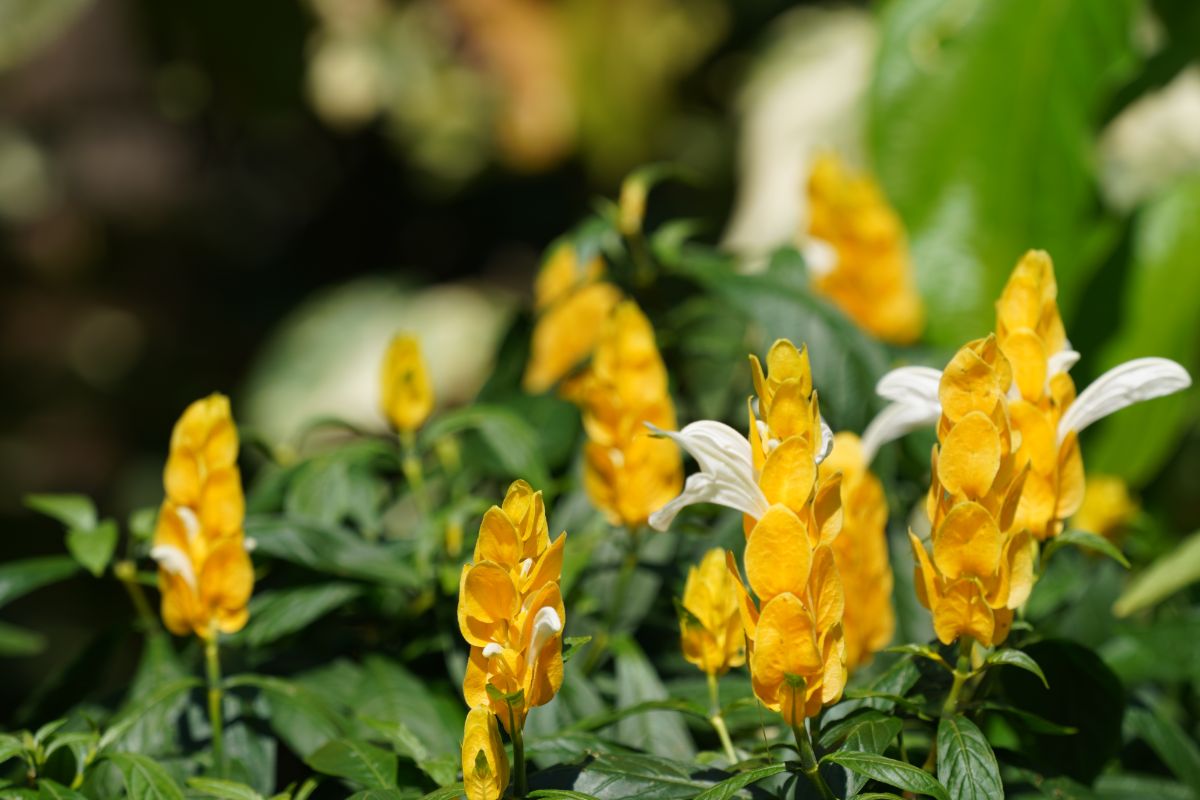
From pale yellow to a deep golden orange, you’ll find a variety of plants with buttery yellow flowers and leaves in the list below!
1. Gerbera Daisy (Gerbera jamesonii)
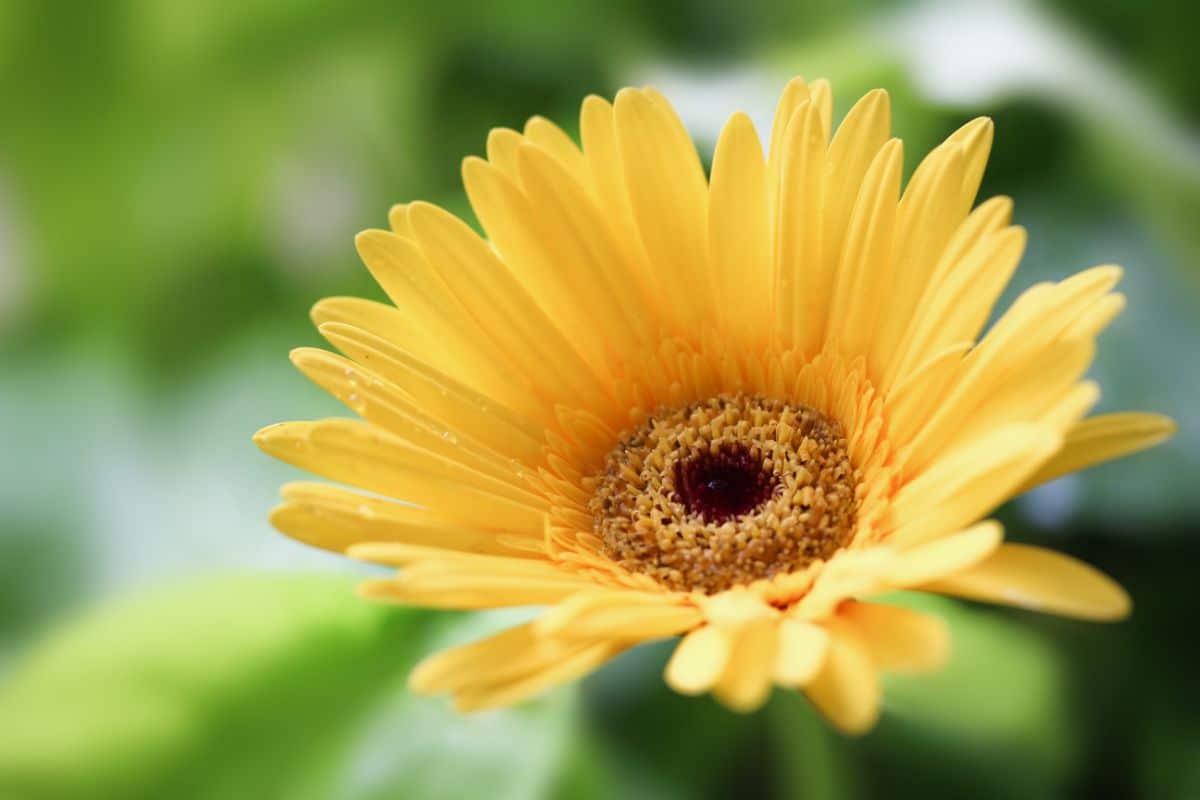
| Plant name: | Gerbera daisy |
| Light requirements: | Bright light |
| Water requirements: | Moderate |
| Pet safe? | Yes |
| Notable features? | Big flowers; Pet safe; Indoor air purifier; Popular with kids |
One of the cheeriest plants you can add to your home, gerbera daisies have large, open flowerheads that come in lots of bright colors, including orange, pink, and yellow. Also known as the Transvaal or African daisy, these plants come from South Africa, and they are well-known for their ability to improve indoor air quality.
Gerbera daisies have a sunny disposition, and they love the bright sun too! A top choice for children’s rooms, Gerbera daisies are non-toxic and safe to keep in homes with pets. They also don’t have any special humidity requirements, but they should always be bottom watered to keep their leaves from developing mildew.
2. Orchids (Orchidaceae spp.)
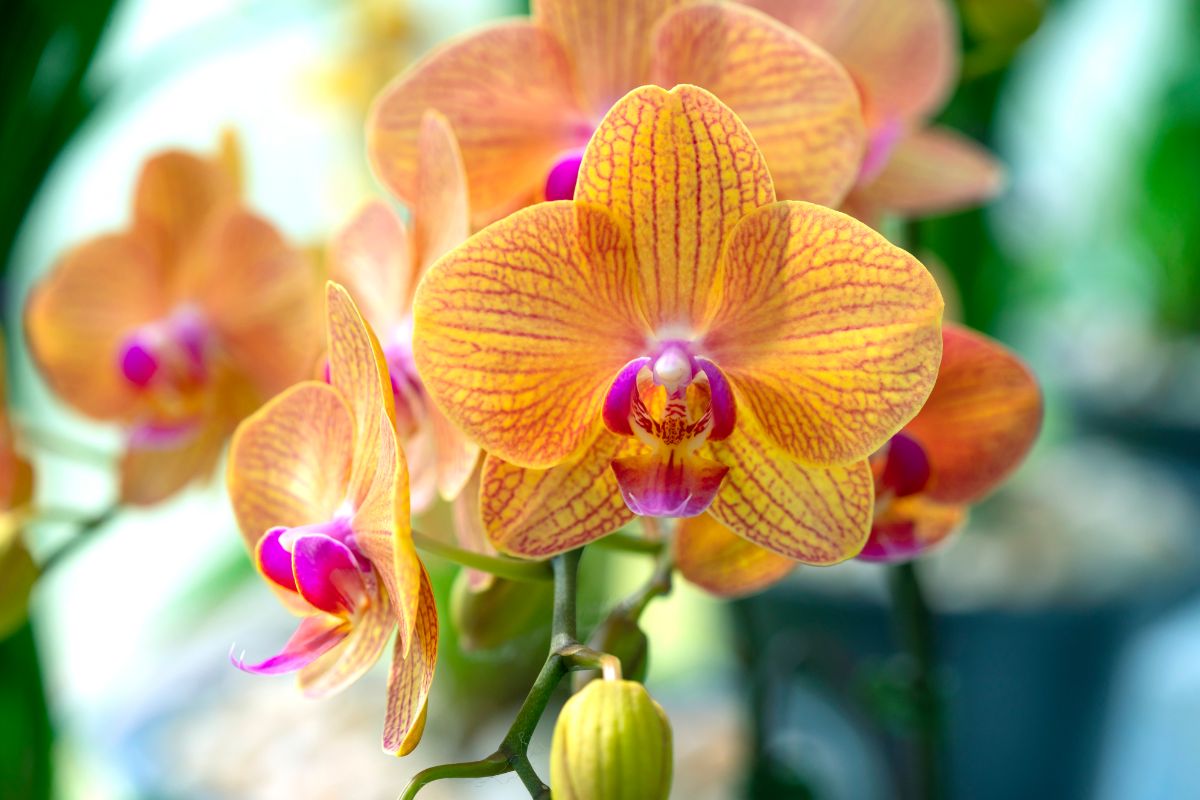
| Plant name: | Orchids |
| Light requirements: | Depends on variety |
| Water requirements: | Depends on variety |
| Pet safe? | Yes |
| Notable features? | Long-lasting flowers; Good for hanging pots |
Orchids have a reputation for being complicated plants to grow, but if you choose an easygoing orchid type, like the moth orchid (Phalaenopsis), these plants can be just as simple to keep as most other tropical houseplants. Moth orchids are just one orchid type that displays yellow flowers, but oncidium orchids and other orchid varieties can also have yellow blooms.
The trick to keeping orchids happy is to ensure they have plenty of humidity, and most orchids prefer bright, indirect light. To boost humidity around your orchids, consider adding a pebble tray beneath your plant’s pot. If you want to grow a lot of orchids in a small space, you can also install a humidifier to boost ambient humidity levels.
3. Bromeliads (Bromeliaceae spp.)
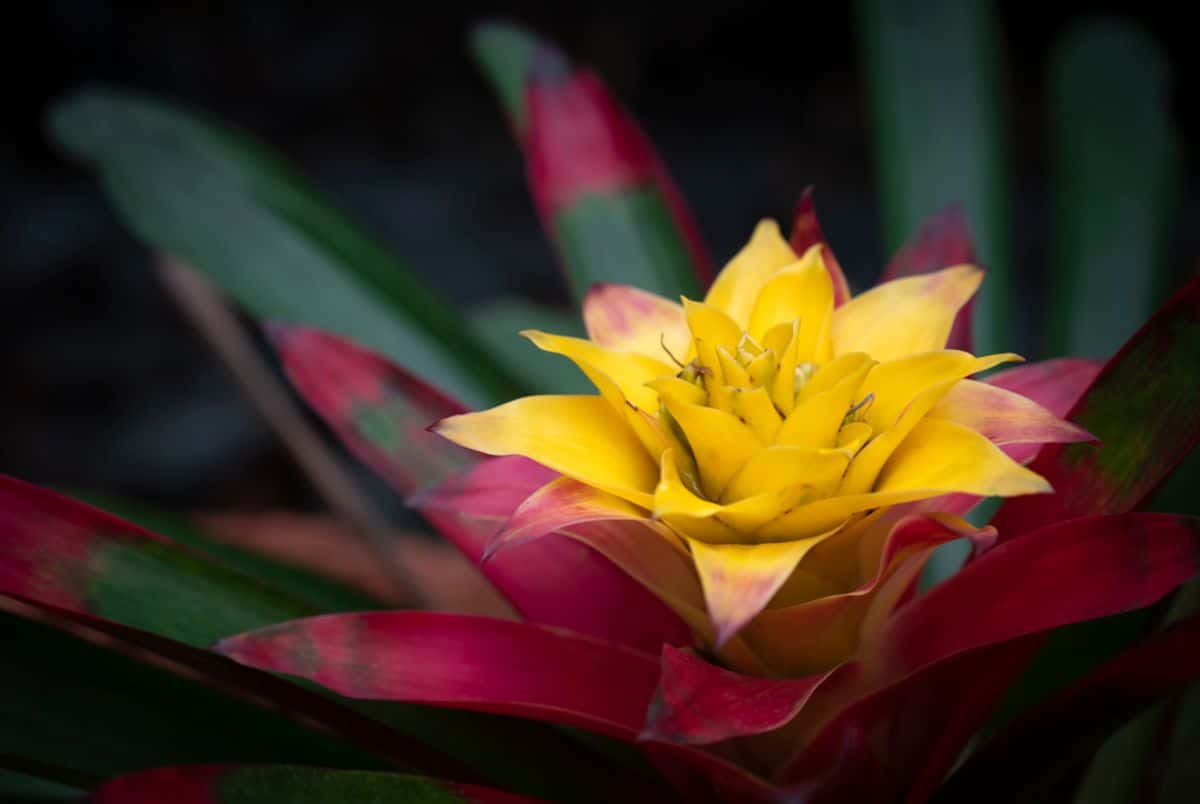
| Plant name: | Bromeliads |
| Light requirements: | Bright light to bright, indirect light |
| Water requirements: | Moderate to low |
| Pet safe? | Yes |
| Notable features? | Long-lasting flowers; Pet safe |
Bromeliads have showstopping blooms that come in many different colors, including yellow. Different bromeliad types may display different flower shapes, but these plants all have one thing in common: they’re monocarps. That means bromeliads only bloom once, but they put on quite a display when they do!
Like orchids, most bromeliads grow as epiphytes on trees in the wild, and they should be kept in a coarse, well-draining potting mix when grown in pots to prevent waterlogged roots. Some bromeliads have a water reservoir in the center of their leaves. When watering these plants, they should be watered in the reservoir and at the soil line.
4. Crotons (Codiaeum variegatum)
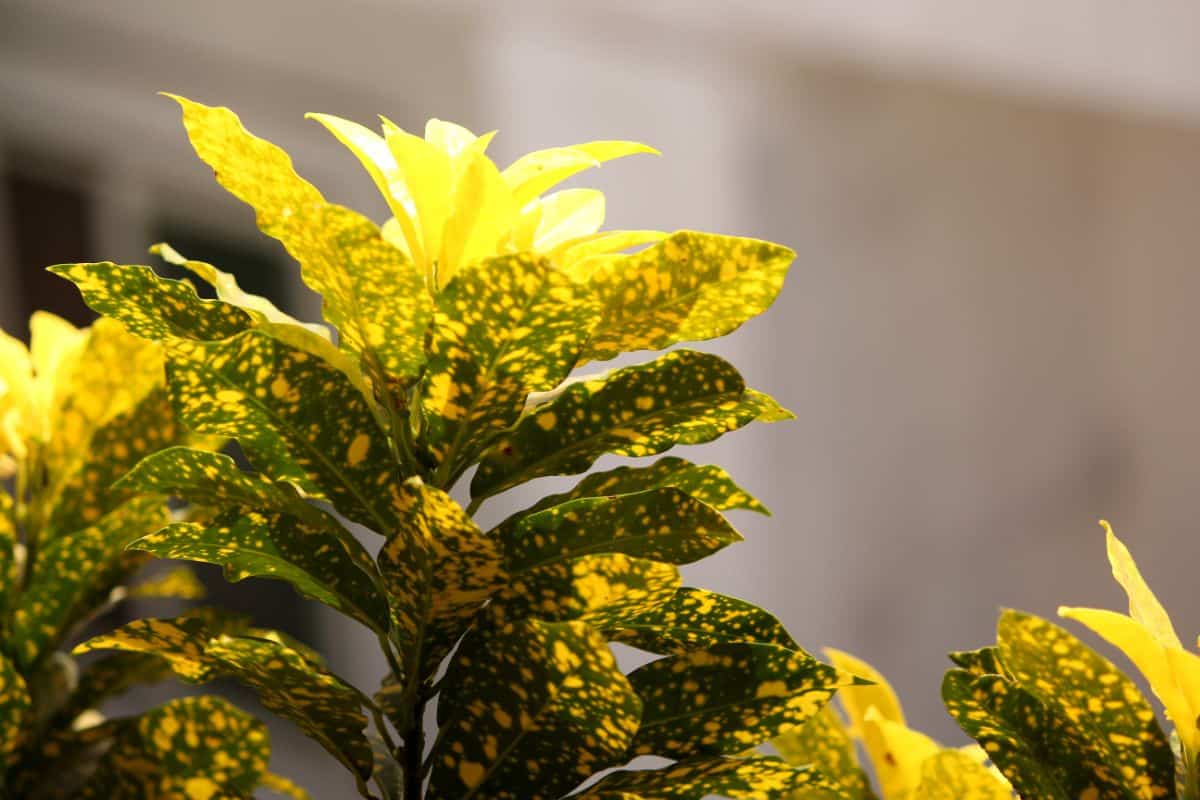
| Plant name: | Crotons |
| Light requirements: | Bright, indirect light |
| Water requirements: | Moderate |
| Pet safe? | No |
| Notable features? | Good for outdoor or indoor planting |
Crotons are frequently grown in containers outdoors in autumn, but they also make fantastic houseplants. These colorful foliage plants are prized for their brilliant leaves that often display a patchwork of green, red, and yellow coloration. You can find many different crotons at most plant nurseries, but varieties like ‘Petra’ and ‘Gold Dust’ are particularly popular.
Crotons are sturdy plants that develop woody stems as they grow. A mature croton can reach up to 10’ tall, but they often stay much smaller when grown in pots. While crotons are relatively disease-proof, they can be susceptible to mealybugs and scale, so keep a lookout for these pesky insects if you keep croton plants.
5. Golden Shrimp Plant (Pachystachys lutea)
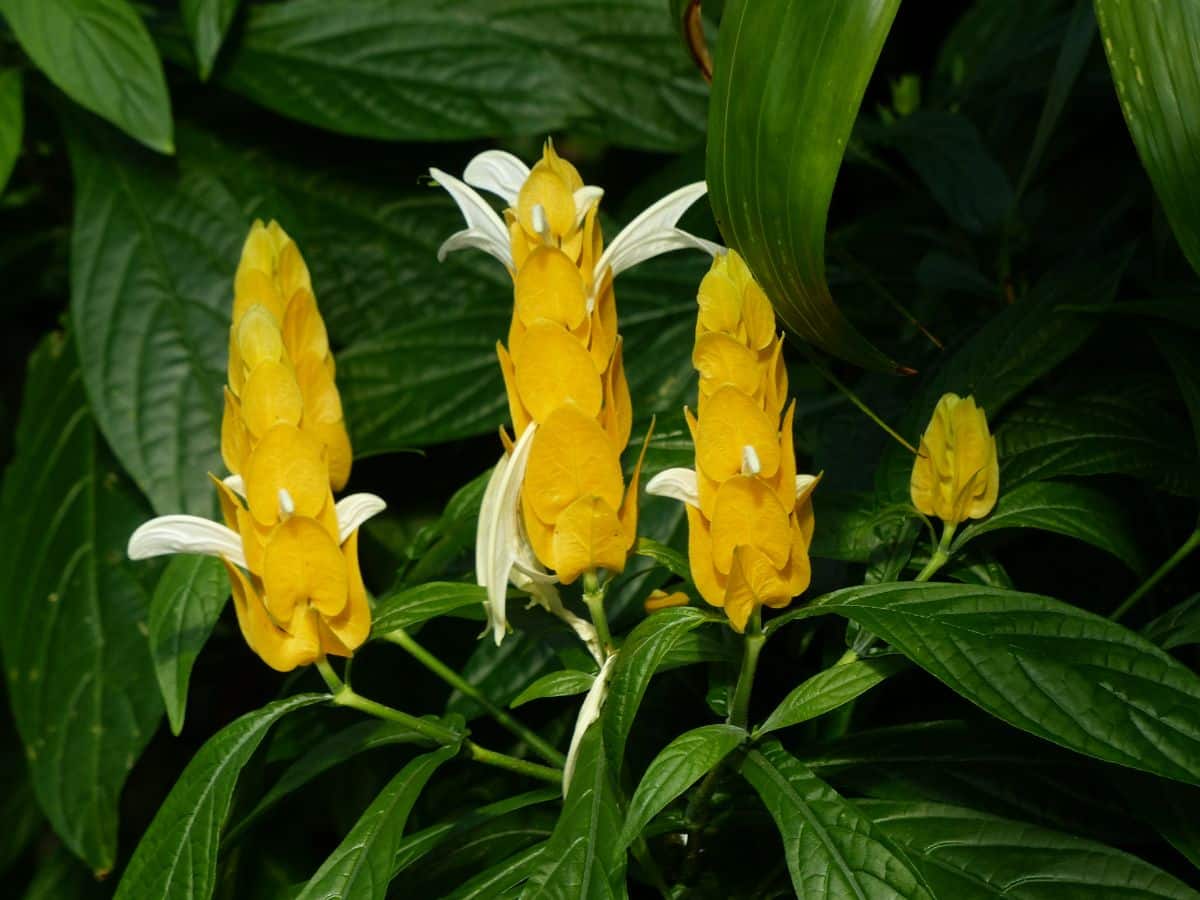
| Plant name: | Golden shrimp plant |
| Light requirements: | Bright, indirect light |
| Water requirements: | High to moderate |
| Pet safe? | No |
| Notable features? | Can be grown outdoors in warm climates |
In zones 10 and 11, golden shrimp plants are often grown outdoors as ornamentals, but they can also adapt to indoor life in cooler climates. When mature, golden shrimp plants sprout white flowers on top of their yellow bracts. Bracts may look like flowers, but they’re actually modified leaf structures that can also be found on poinsettia and some other ornamental plants.
When grown indoors, golden shrimp plants will often bloom in spring and summer, and they should be sheltered from direct sun, which can cause leaf burn. For best results, provide golden shrimp plants with a bit of extra humidity to prevent crispy leaves.
6. Lithops (Lithops spp.)
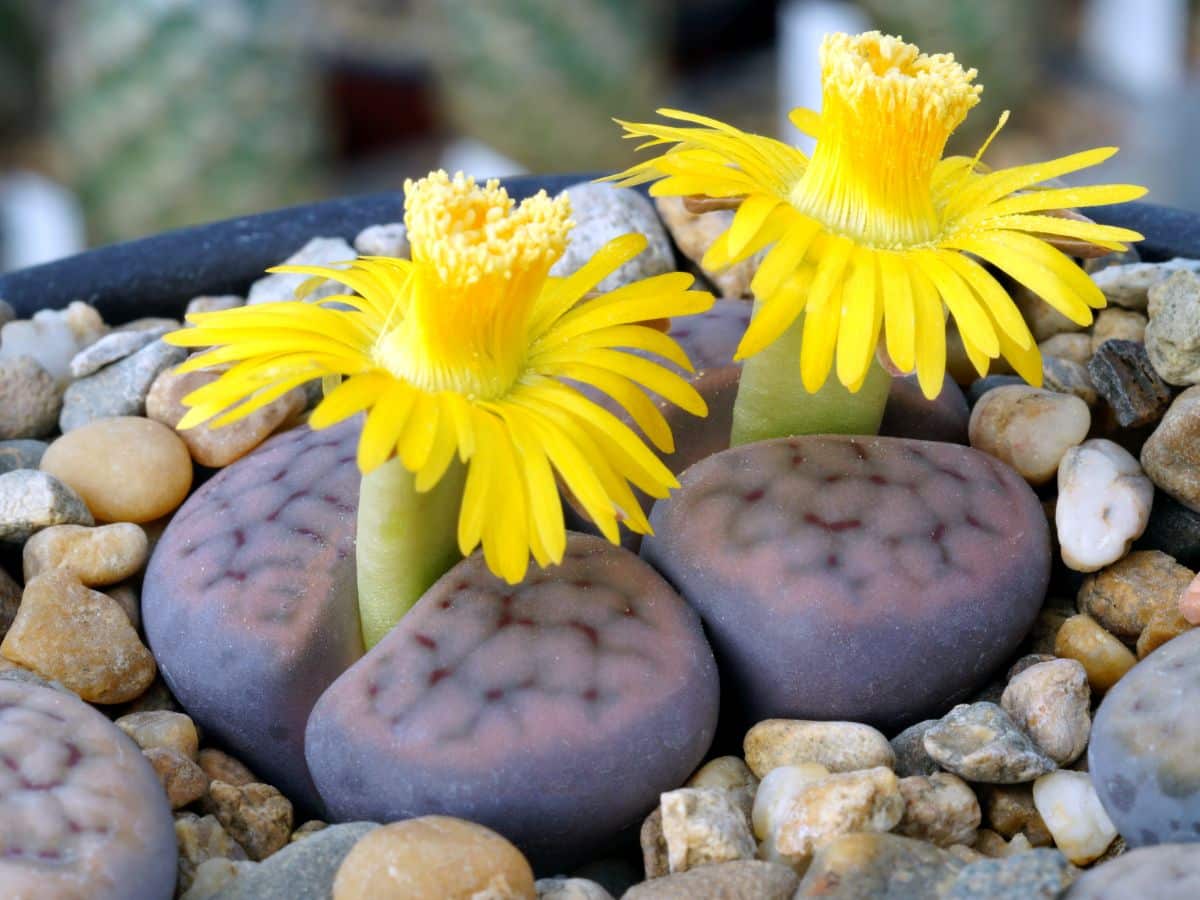
| Plant name: | Lithops |
| Light requirements: | Bright light |
| Water requirements: | Low |
| Pet safe? | Yes |
| Notable features? | Low maintenance; Popular with kids |
Lithops are curious-looking succulents that come in many colors, and they’re mostly known for their oddball forms. But lithops can also bloom delicate, daisy-like flowers with white, orange, or yellow petals. Flowering usually occurs in autumn or late winter, and, when lithops bloom, they can easily liven up your houseplant collection.
Like most other succulents, lithops have minimal care needs, and they need very little water. Lithops are also some of the smallest plants you can find, so if you’re looking for a plant to fit in a mini pot, you may want to try out these petite plants!
7. Caladiums (Caladium bicolor)
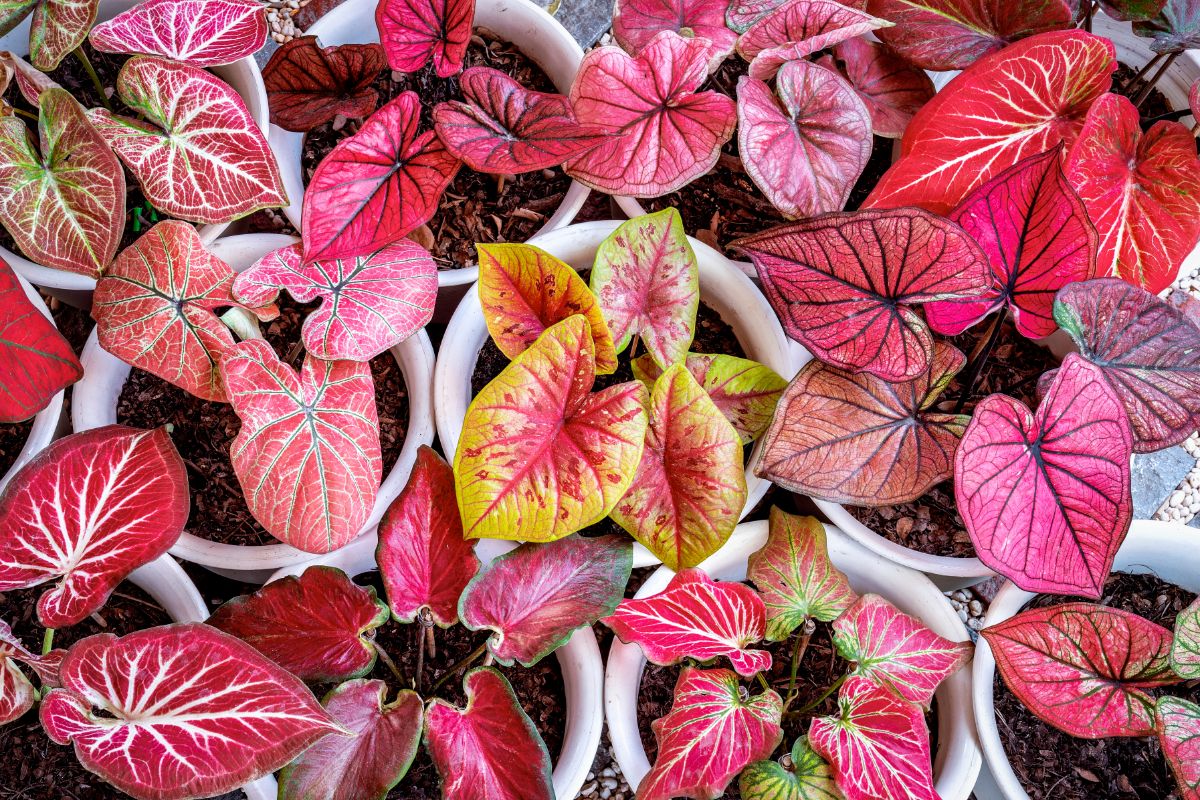
| Plant name: | Caladiums |
| Light requirements: | Bright, indirect light |
| Water requirements: | Moderate |
| Pet safe? | No |
| Notable features? | Good for outdoor or indoor planting |
Caladiums are often grown as outdoor plants in container gardens, but their colorful leaves also make them a hit with houseplant keepers. Caladium leaves are quite thin, and they look particularly alluring when backlit by the sun. And while you can find caladiums with yellow to neon green leaves, caladiums also come in white, red, and other delightful colors.
When kept indoors, caladiums will need extra humidity to keep their leaves in tip-top shape. These plants also require bright, indirect light, and too much sun can damage their delicate leaves.
8. ‘Widow’s Thrill’ Kalanchoe (Kalanchoe blossfeldiana)
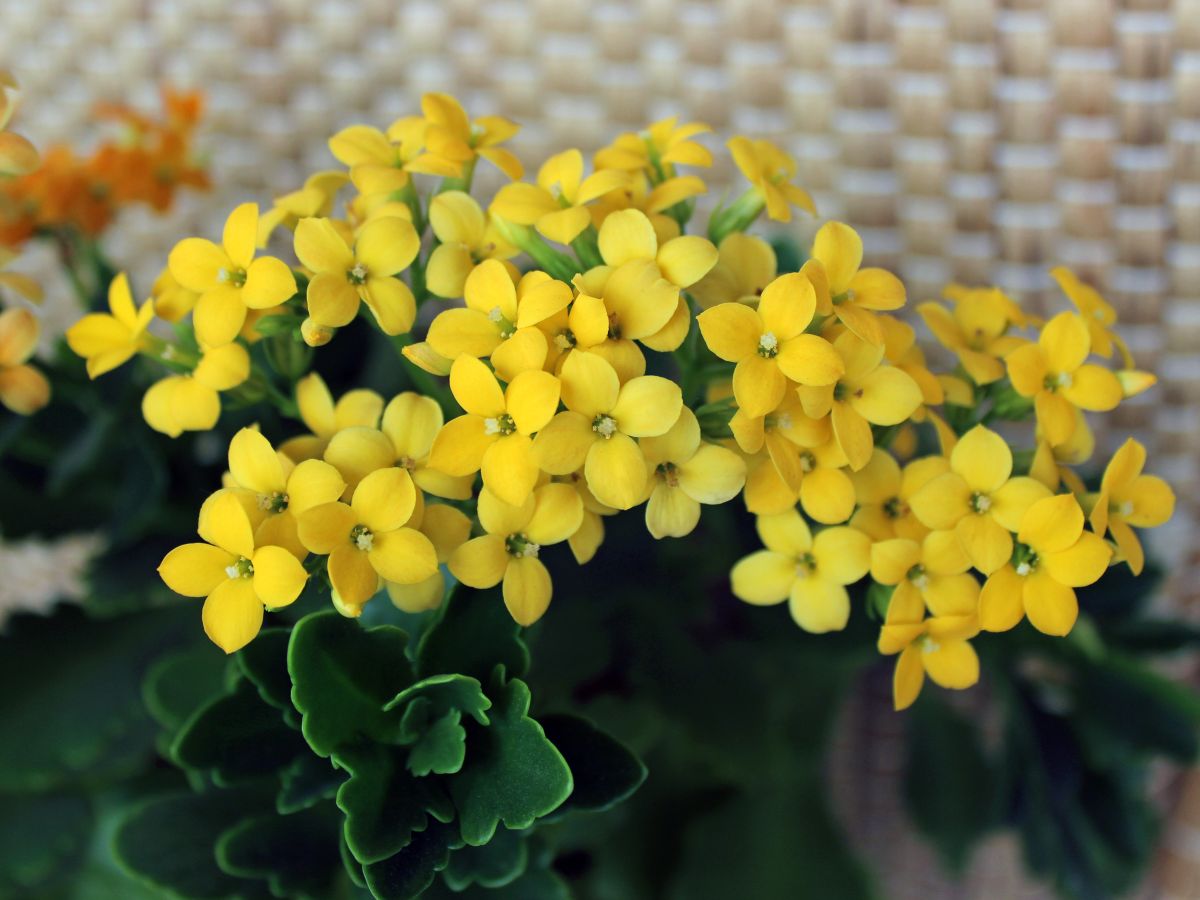
| Plant name: | ‘Widow’s Thrill’ Kalanchoe |
| Light requirements: | Bright, indirect light |
| Water requirements: | Low |
| Pet safe? | No |
| Notable features? | Low maintenance; Long-lasting flowers |
There are about 125 different types of kalanchoe, including the ever-popular fuzzy panda plant. But if you’re looking for a houseplant with buttery-yellow color, ‘Widow’s Thrill’ is the kalanchoe for you.
Also known as the florist’s kalanchoe, ‘Widow’s Thrill’ produces clusters of small and colorful flowers. Blooms come in a range of hues, including canary yellow, and they last a long time. Even when ‘Widow’s Thrill’ isn’t in bloom, you can still enjoy this plant’s bright green, fleshy leaves and undemanding nature.
9. Snake Plants (Dracaena trifasciata)
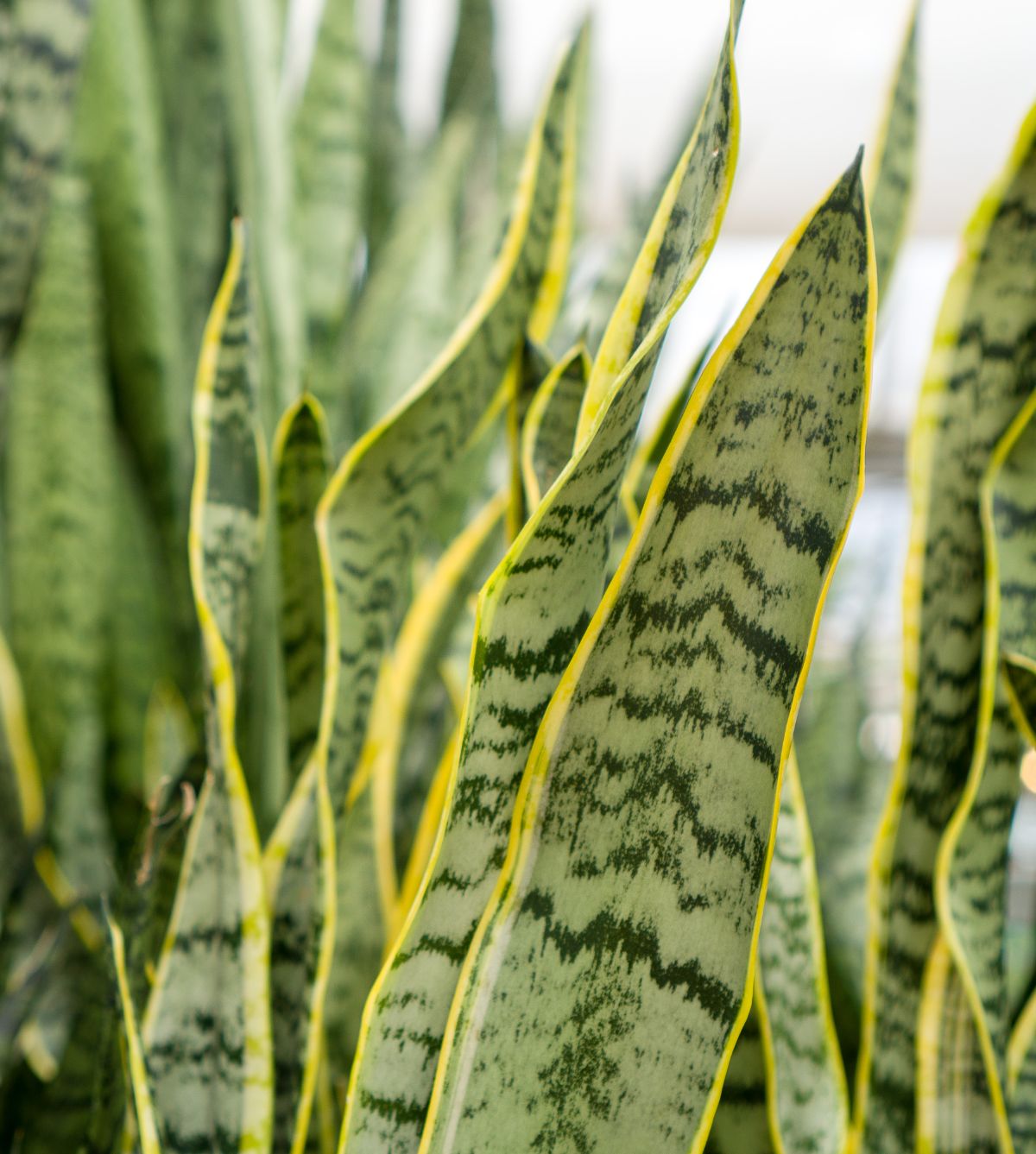
| Plant name: | Snake plants |
| Light requirements: | Bright light to low light |
| Water requirements: | Low |
| Pet safe? | No |
| Notable features? | Low maintenance |
When you think of yellow plants, you might not consider snake plants. But while most snake plants have green leaves, some variegated varieties feature bright yellow striping on their leaf margins. If you’re on the hunt for yellow plants, snake plants can make a fabulous addition to your plant collection, and they’re ultra-low maintenance too.
While snake plants will grow best in bright, indirect light, they can tolerate low-light environments, and they need very minimal water. Occasionally, snake plants will also flower, but this is more common in plants that are kept outdoors.
10. Marble Buttons (Conophytum calculus)
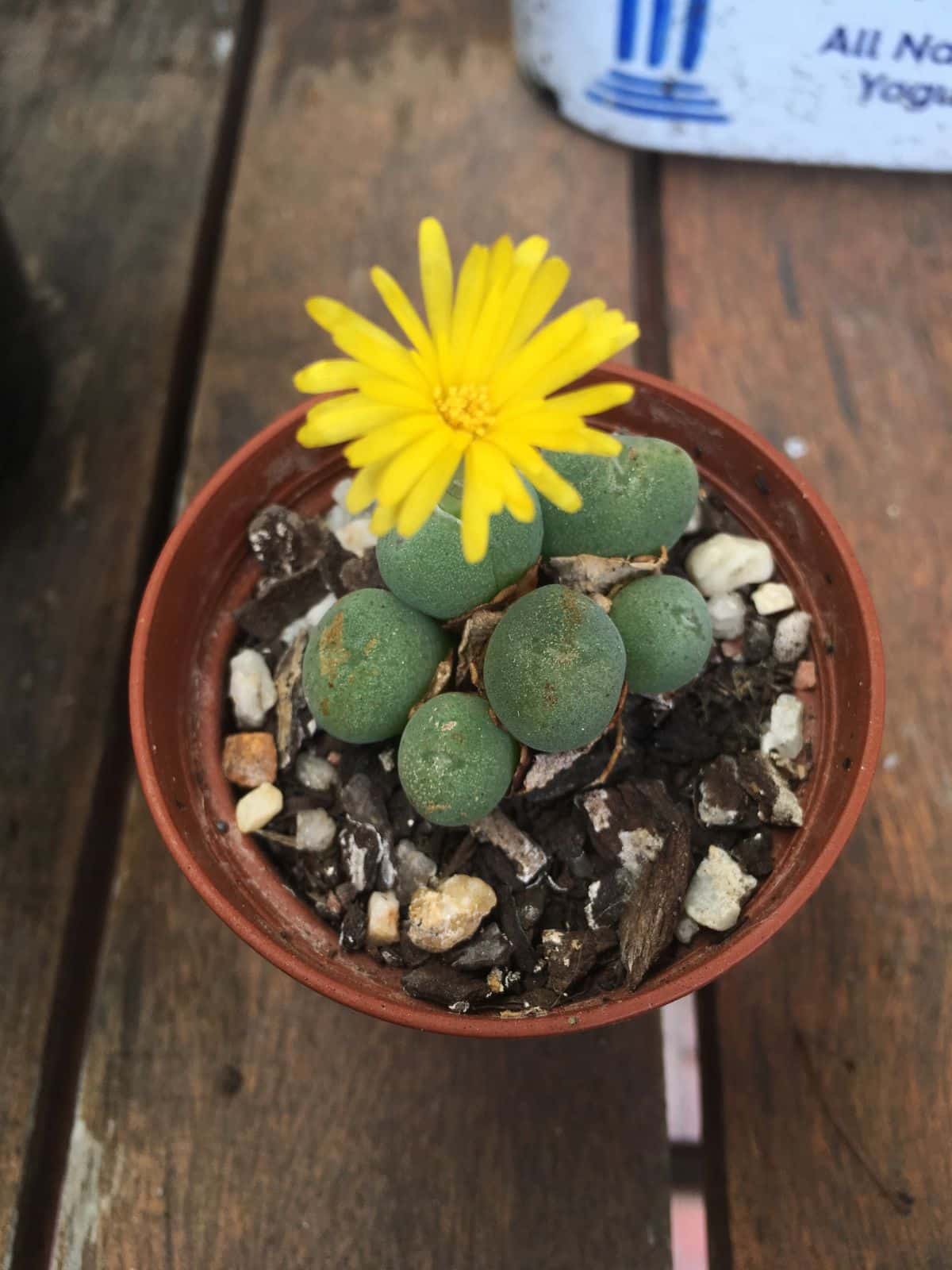
| Plant name: | Marble buttons |
| Light requirements: | Bright, indirect light |
| Water requirements: | Low |
| Pet safe? | No data |
| Notable features? | Low maintenance |
If you love lithops, you’ll adore marble buttons! These quirky succulents look a lot like lithops, and they also bloom small, yellow to orange flowers that are shaped a bit like daisies. Mature plants have globular forms, and they rarely grow over 1” tall, making them well-suited for growing in even the smallest plant pots.
Marble buttons can be difficult to find, but you may be able to order them online. To keep your plants happy, shelter marble buttons from direct light and water them sparingly. Watering should be reduced even further when these plants enter a state of dormancy in spring.
11. Golden Pothos (Epipremnum aureum)
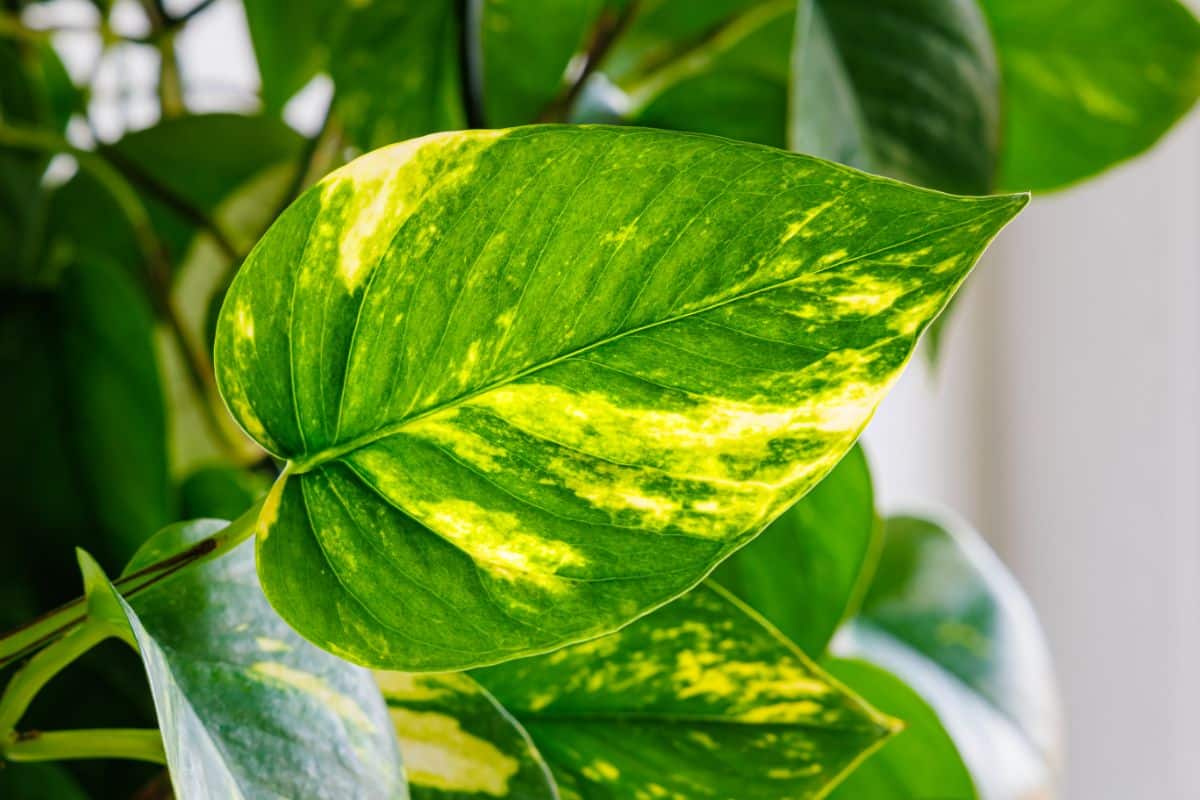
| Plant name: | Golden pothos |
| Light requirements: | Bright, indirect light to low light |
| Water requirements: | Moderate |
| Pet safe? | No |
| Notable features? | Low maintenance; Easy to propagate; Great for hanging baskets |
Pothos are some of the easiest plants to keep, and they can grow vigorously in even low light conditions where other houseplants won’t thrive. Most pothos develops long vines as they mature that can trail gracefully from high shelves or hanging baskets, or they can be trained on trellising. Pothos are also one of the few houseplants that can be grown in water.
From marble pothos to silver pothos, there are lots of different pothos to choose from. However, if you love the color yellow, the yellow accents on golden pothos’ leaves are sure to delight. You may also want to try out neon pothos, which is a bright chartreuse green, rather than yellow, but it can blend right in with other yellow houseplants.
12. Philodendron 'Aurea' (Philodendron bipennifolium)
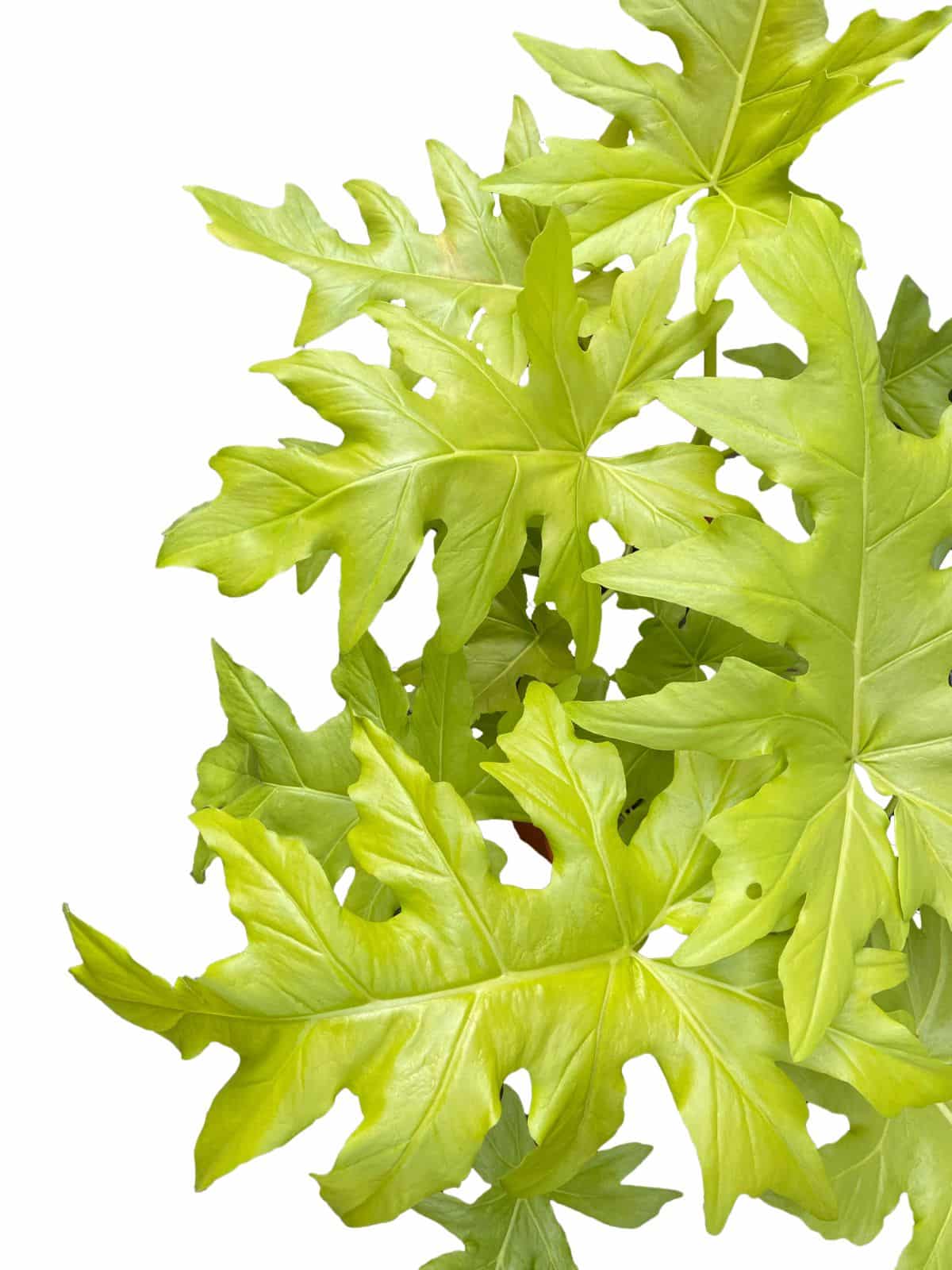
| Plant name: | Philodendron ‘Aurea’ |
| Light requirements: | Bright, indirect light |
| Water requirements: | Moderate |
| Pet safe? | No |
| Notable features? | Showy leaves |
Philodendron ‘Aurea’ is a rarer houseplant, and you may need to do a bit of digging to find a cutting online. But if you love unique houseplants with flashy leaves, ‘Aurea’ is hard to beat. Like neon pothos, ‘Aurea’ has chartreuse, rather than yellow leaves, but those leaves can take on a yellow cast in certain light, and they coordinate beautifully with yellow houseplants.
Since philodendron ‘Aurea’ can be prone to root rot, it should be grown in a well-draining potting mix and only watered when the top 2 to 3” of soil feels dry to the touch. If you keep this plant in a bright window, consider adding a sheer curtain to your setup to shelter the plant’s leaves from the intense afternoon sun.
13. Sweet Potato Vine (Ipomoea batatas)
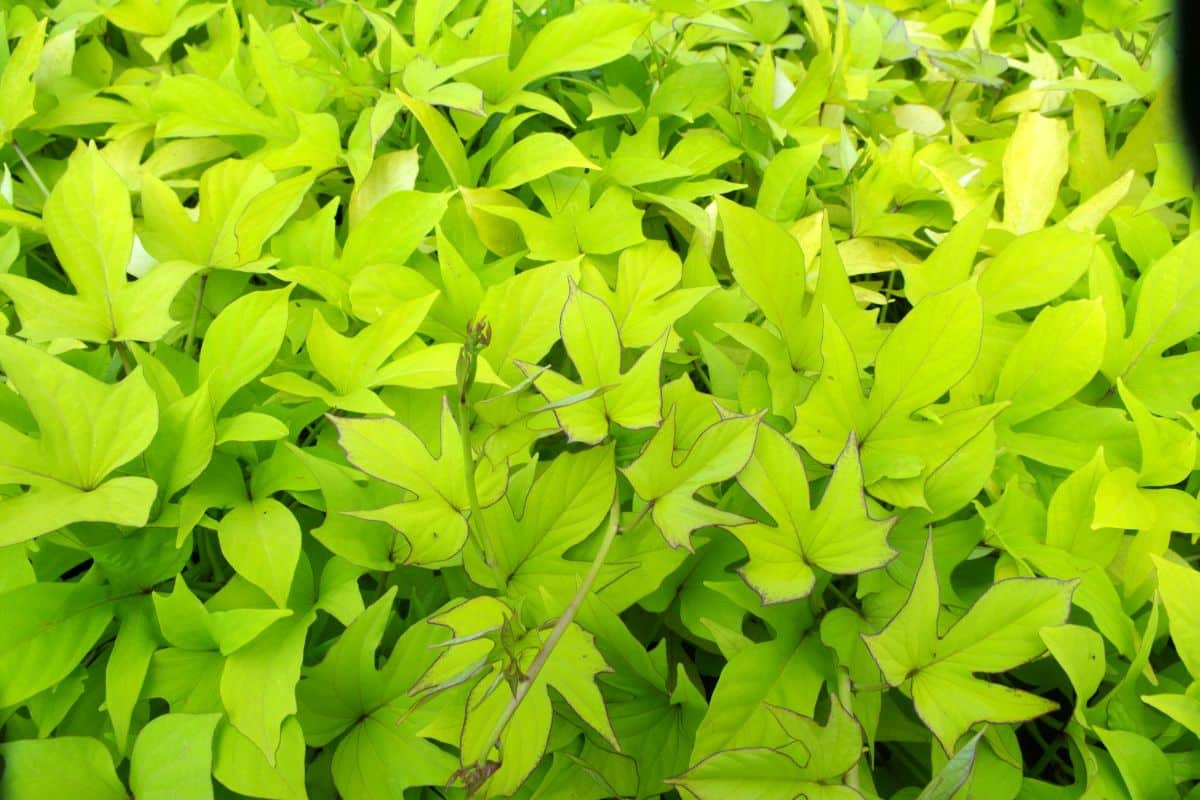
| Plant name: | Sweet potato vine |
| Light requirements: | Bright light to bright, indirect light |
| Water requirements: | High to moderate |
| Pet safe? | No |
| Notable features? | Great for hanging baskets; Good for outdoor or indoor planting |
Like caladiums and crotons, sweet potato vines are staples in outdoor container gardens, but they can also make satisfying houseplants. These vining plants can be grown in hanging baskets or planted up with other easy-care houseplants for a mixed plant display. While sweet potato vines come in darker colors, if you collect yellow plants, look for the golden sweet potato vine, which has neon green to yellow leaves.
Sweet potato vines are technically the same plants as edible sweet potatoes, but they have been cultivated for their ornamental appeal rather than their edible roots. As a result, they may produce edible tubers, but those tubers will usually be smaller and less tasty than sweet potato plants intended for vegetable gardens.
14. Hibiscus (Hibiscus spp.)
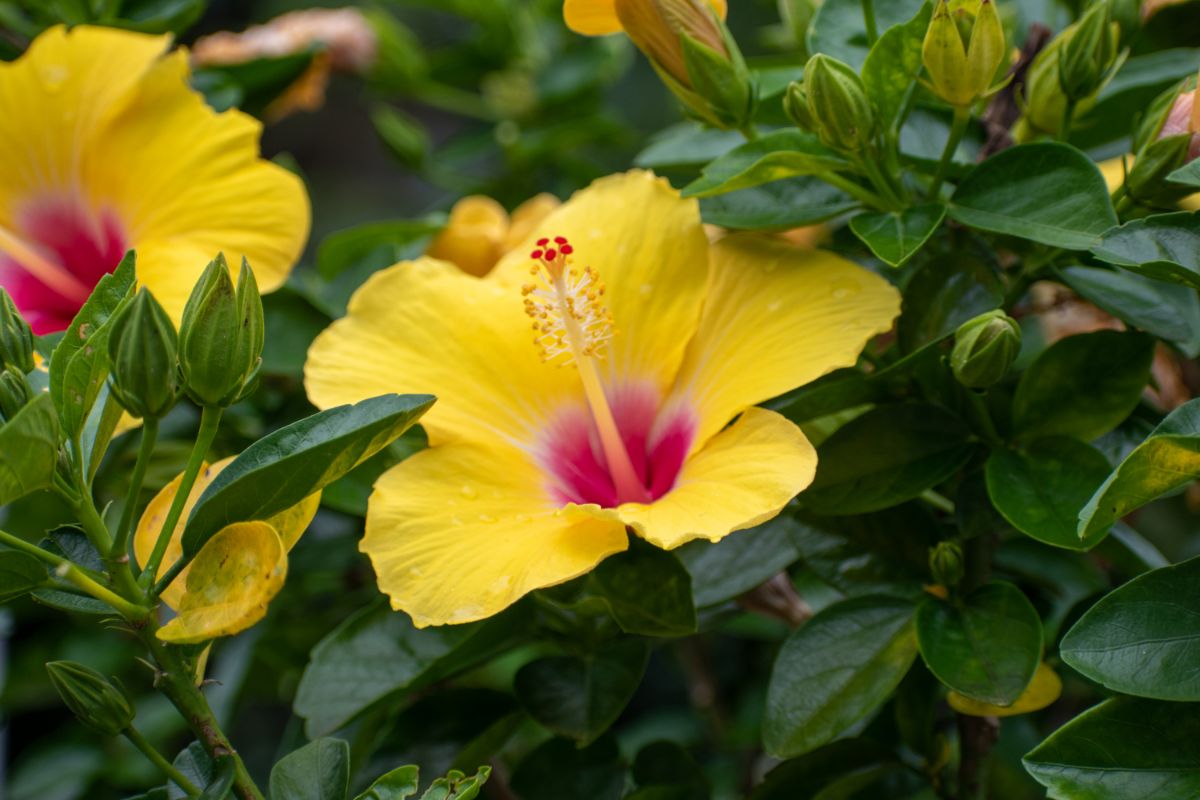
| Plant name: | Hibiscus |
| Light requirements: | Bright light |
| Water requirements: | High to moderate |
| Pet safe? | No |
| Notable features? | Some varieties are edible; Good for outdoor or indoor planting |
Hibiscus are often grown outdoors, but you can find dwarf hibiscus varieties that are small enough to grow in pots. When kept indoors, hibiscus requires plenty of light, and plants will usually need a humidity boost to keep their leaves from drying out. Hibiscus flowers come in loads of different colors, including a sunny yellow, and some hibiscus flowers are even edible!
15. ‘Song of India’ Dracaena (Dracaena reflexa)
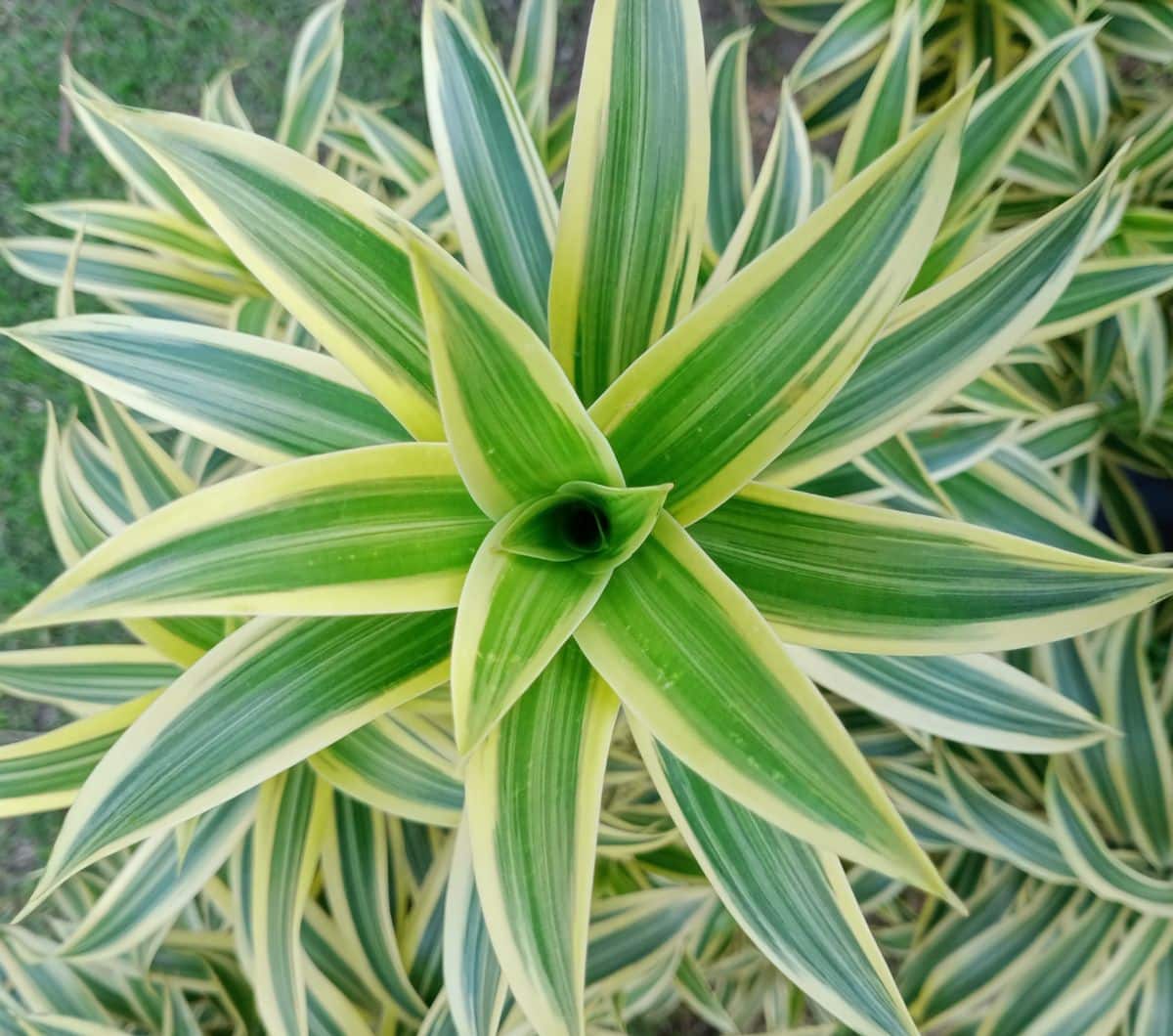
| Plant name: | ‘Song of India’ Dracaena |
| Light requirements: | Bright, indirect light |
| Water requirements: | Moderate |
| Pet safe? | No |
| Notable features? | Showy leaves |
Dracaena are some of the most common houseplants on the market today, and you can usually find a variety of them at local plant nurseries. But if you want a yellow houseplant, ‘Song of India’ may be the dracaena for you as this plant has highly variegated leaves with yellow striping.
Like other dracaena plants, ‘Song of India’ is relatively undemanding, and it makes a fantastic foliage plant. These plants can also occasionally produce small, white blooms, but flowering is less likely to occur in indoor plants.
16. ‘Yellow Fusion’ Calathea (Calathea louisae)
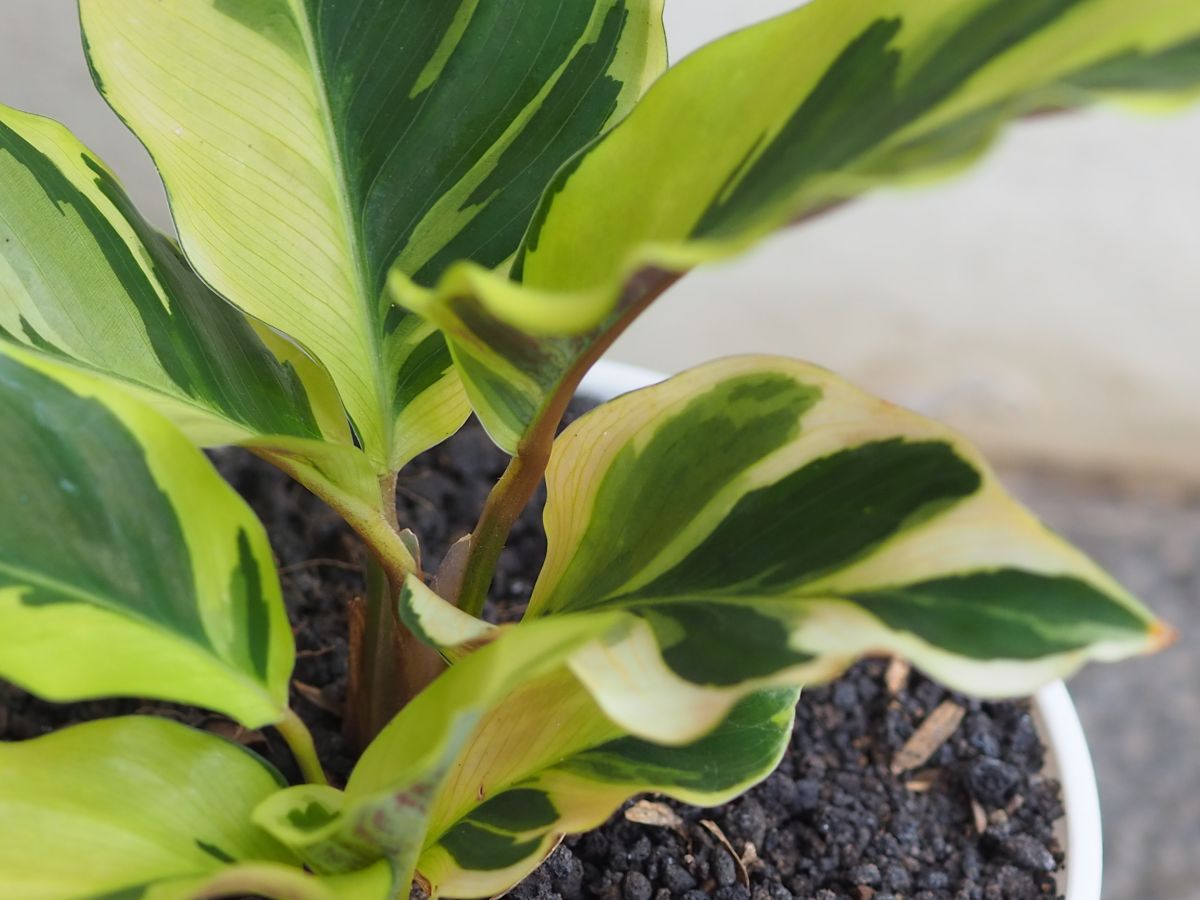
| Plant name: | ‘Yellow Fusion’ Calathea |
| Light requirements: | Bright, indirect light |
| Water requirements: | Moderate |
| Pet safe? | Yes |
| Notable features? | Showy leaves |
A close relative of prayer plants and rattlesnake plants, calathea are famous for their boldly patterned leaves, and ‘Yellow Fusion’ is no exception. This rare plant can be tricky to find, but if you can track it down, it will reward you with a mélange of yellow and lime green leaves. Like other calathea, ‘Yellow Fusion’s’ leaves move with the light, and they can turn upwards in the evening to conserve moisture.
17. ‘Prince of Orange’ Philodendron (Philodendron erubescens)

| Plant name: | ‘Prince of Orange’ Philodendron |
| Light requirements: | Bright, indirect light |
| Water requirements: | Moderate |
| Pet safe? | No |
| Notable features? | Showy leaves |
There’s no doubt about it: ‘Prince of Orange’ is one bold plant that is certain to be the star of your houseplant collection. This philodendron variety has color-changing leaves that are bright, sunshine yellow when they first unfurl. As the leaves age, they transition into a deep orange and then fade into a rich, green tone, providing lots of interest and variety throughout the season.
18. ‘Nonstop Yellow’ Begonia (Begonia x tuberhybrida)
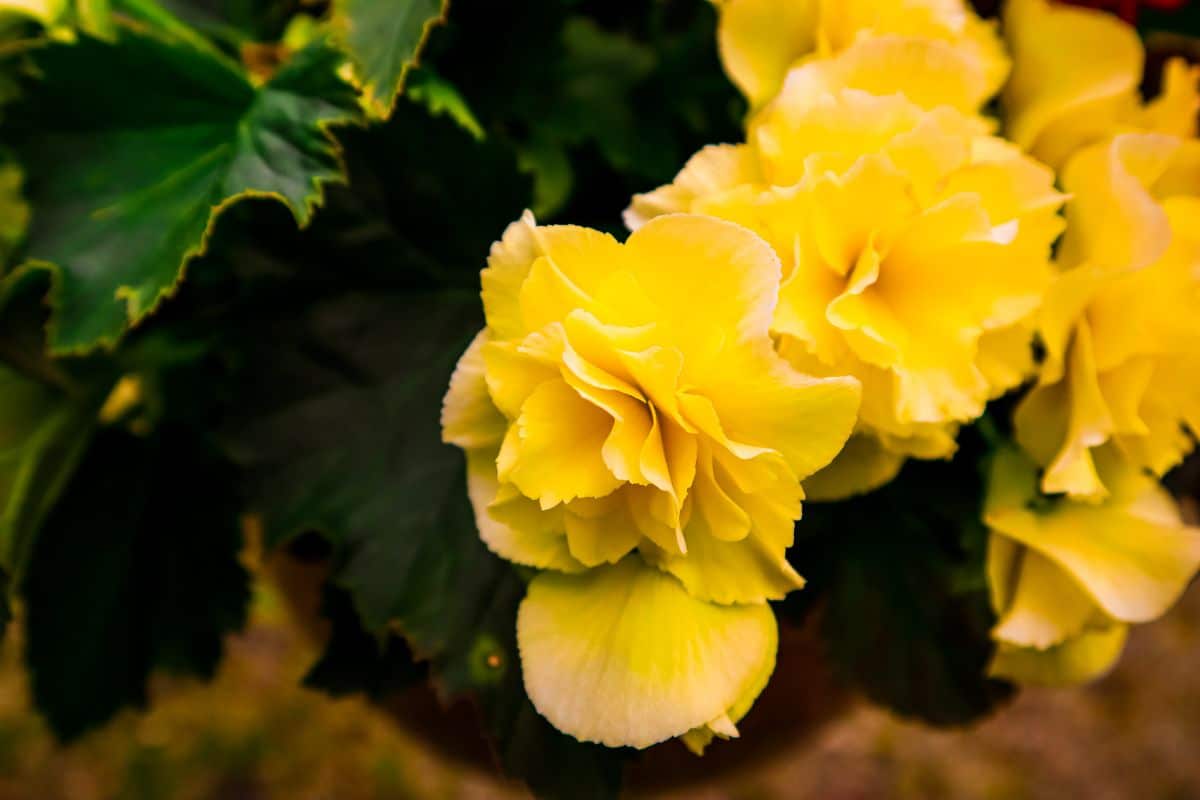
| Plant name: | ‘Nonstop Yellow’ Begonia |
| Light requirements: | Bright, indirect light |
| Water requirements: | Moderate |
| Pet safe? | No |
| Notable features? | Bright flowers |
Many begonias produce showy clusters of flowers, but if you’re after yellow plants, you need to pick up a ‘Nonstop Yellow’ begonia. In warm areas, these plants can be grown outdoors, but they also make fantastic houseplants as long as you provide them with bright, indirect light and extra humidity.
Like other begonias, ‘Nonstop Yellow’ can be prone to mildew issues, so always water this plant at the soil line and do what you can to keep the leaves dry. These plants will need even less water during winter, but they have a long bloom time and can produce vivid yellow flowers throughout the year.
19. Primrose (Primula vulgaris)
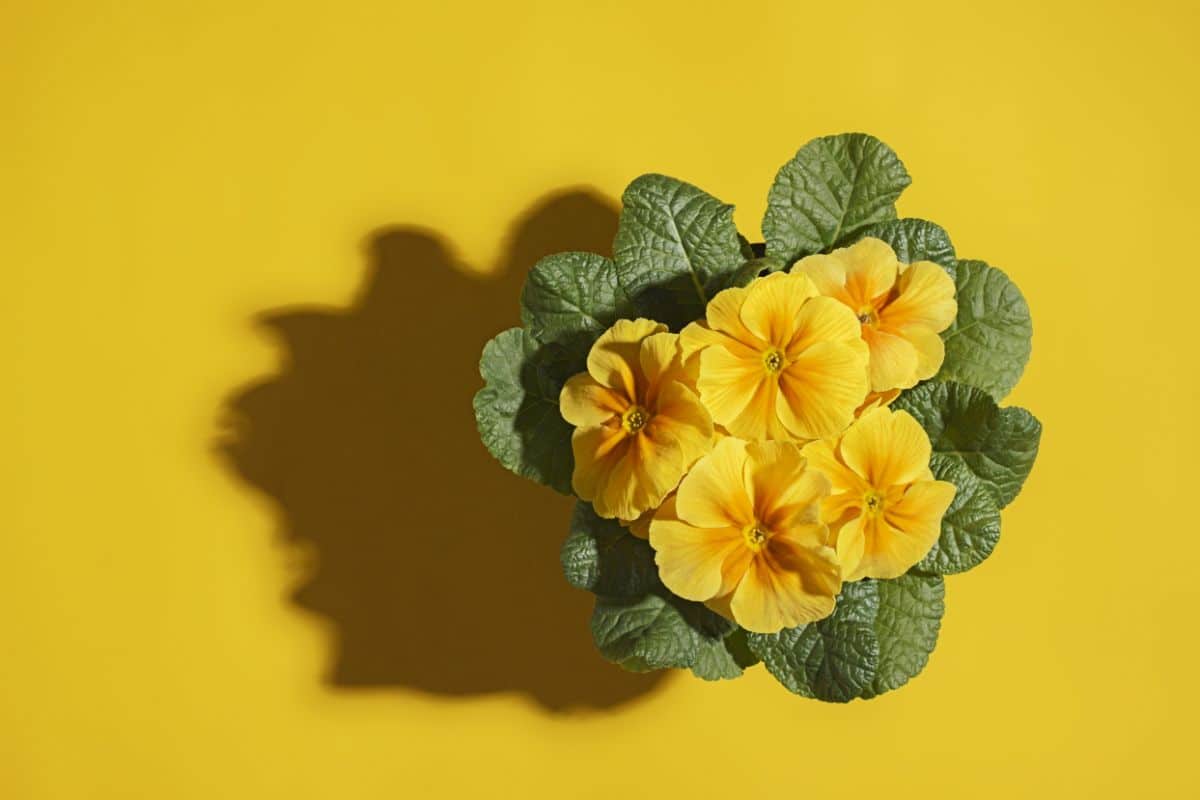
| Plant name: | Primrose |
| Light requirements: | Bright, indirect light |
| Water requirements: | High |
| Pet safe? | No |
| Notable features? | Bright flowers |
Like some of the other plants on this list, primroses are often grown outdoors, but they can also be kept inside with a bit of extra care. Primroses produce a rainbow of flower colors, including yellow, but they do need extra humidity when kept indoors. While humidifiers and pebble trays can help maintain the health of primroses, these plants are also small enough to keep in terrariums, which can modulate the humidity levels for you.
The trick to keeping primrose happy is to find a proper balance when watering. These plants can be prone to root rot, but they also wilt dramatically if their soil dries out. To avoid this, keep the soil moist but not soggy, and water your plants as soon as the top of the soil feels dry.
20. Coleus (Plectranthusscutellarioides)

| Plant name: | Coleus |
| Light requirements: | Bright, indirect light |
| Water requirements: | High |
| Pet safe? | No |
| Notable features? | Showy leaves; Good for outdoor or indoor planting |
Outdoors or indoors, coleus can grow happily just about anywhere, although it will need extra humidity when kept as a houseplant. These foliage plants are top choices in container gardens, but their showy leaves make them popular for indoor settings too.
You can find coleus plants in various shades, but cultivars like ‘Pineapple Express’ and ‘Raspberry Tart’ are some of the top choices for yellow lovers. Some coleus has solid leaf colors, but most coleus varieties have multicolored leaves with pops of red, green, yellow, and other delightful shades.
21. Angel Trumpet (Brugmansia spp.)

| Plant name: | Angel trumpet |
| Light requirements: | Bright light |
| Water requirements: | High |
| Pet safe? | No |
| Notable features? | Big flowers; Good for outdoor or indoor planting |
When grown outdoors, angel trumpet can grow up to 30’ tall, but when the plant is pruned, and its roots are restricted in a small pot, angel trumpet plants usually stop growing when they reach about 4 to 10’ tall. With massive blooms that can stretch 24” long, angel trumpet plants have a very tropical look, and they’re ideal for greenhouses and sunny indoor spaces.
Angel trumpet flowers come in several different colors, including pink and yellow. Some angel trumpets are scent-free, but many have luscious fragrances with notes of citrus, jasmine, and gardenia. As alluring as angel trumpets are, they are quite toxic, and they shouldn’t be kept in homes with pets or small children.
22. Zebra Plant (Aphelandra squarrosa)

| Plant name: | Zebra plant |
| Light requirements: | Bright, indirect light |
| Water requirements: | Moderate |
| Pet safe? | Yes |
| Notable features? | Showy leaves |
Several different species of plants are called zebra plants, but Aphelandra squarrosa is a particularly colorful option that features highly variegated leaves with intense striping. However, while the zebra plant is mostly known for its leaves, it can also dazzle you with its golden yellow flowers that usually appear towards the end of summer.
Zebra plants can be a bit more finicky than some other houseplants, but as long as you provide them with bright, indirect light and plenty of humidity, they should grow just fine. Consider potting up your zebra plant in a boldly colored pot to accentuate the plant’s showy leaves.
23. Bush Lily (Clivia minata)
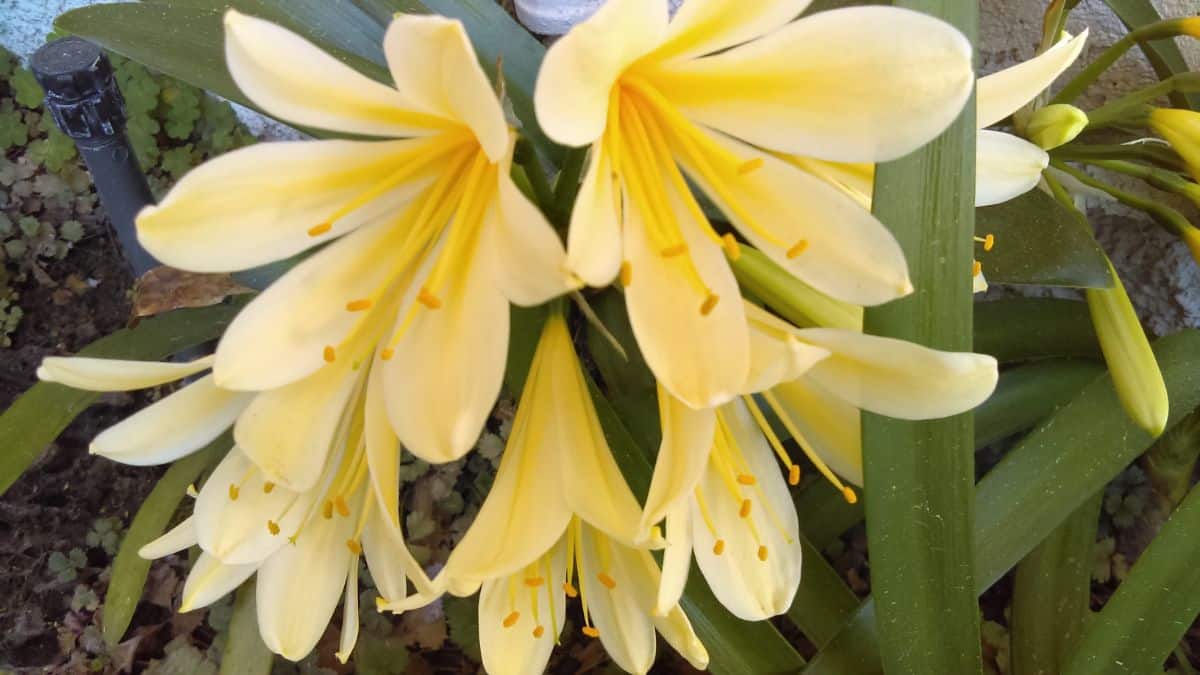
| Plant name: | Bush lily |
| Light requirements: | Bright light |
| Water requirements: | High |
| Pet safe? | No |
| Notable features? | Bright flowers |
Also known as the flame lily or kaffir lily, bush lilies often have orange or reddish flowers, but you can also find cultivars with delicate, pale yellow blooms. These plants can be grown outdoors in warm climates, but they can also be kept inside in a brightly lit window or under a grow light.
Bush lilies are closely related to amaryllis, and, like amaryllis, they prefer to be a bit rootbound and only need to be repotted every few years. You’ll need a bit of patience if you want to grow bush lilies, as they can be slow growers. Indoor plants also require a rest period in fall or winter to jumpstart blooming, and water and fertilizer should be withheld at this time.
24. Prickly Pear (Opuntia spp.)
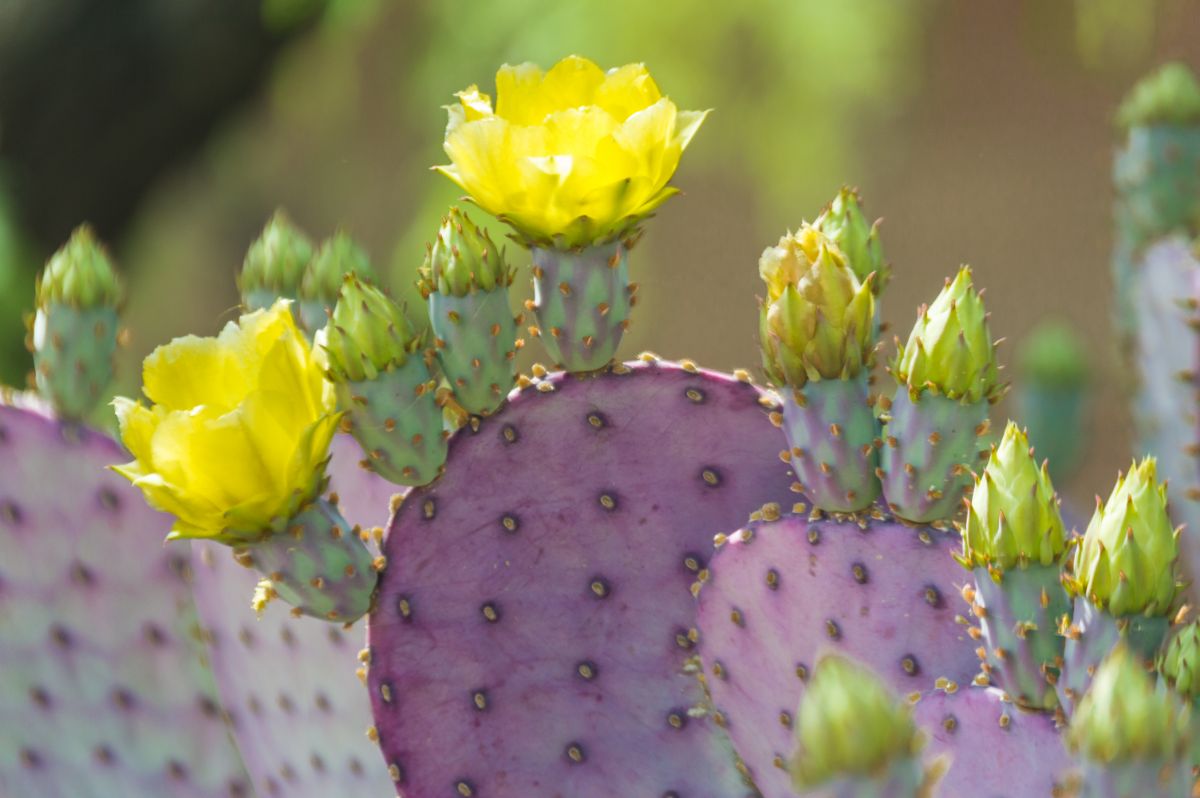
| Plant name: | Prickly pear |
| Light requirements: | Bright light |
| Water requirements: | Low |
| Pet safe? | Yes |
| Notable features? | Edible; Low maintenance |
Prickly pear may look intimidating with their spiky paddles, but this edible cactus is a culinary delight, and it can be grown indoors or outdoors in zones 7 to 10. Both the fruit and paddles of prickly pear cacti are edible, and the paddles, in particular, are commonly used in tacos!
If you collect yellow plants, prickly pear is another must-have. Beyond being tasty, prickly pears have color-changing flowers that are yellow when they first emerge but turn into a vivid orange or pink hue as they mature. Like other cacti, prickly pear is low maintenance and drought-tolerant, and it should be watered sparingly to avoid issues with root rot.
25. ‘Yellow Star’ Amaryllis (Hippeastrum spp.)
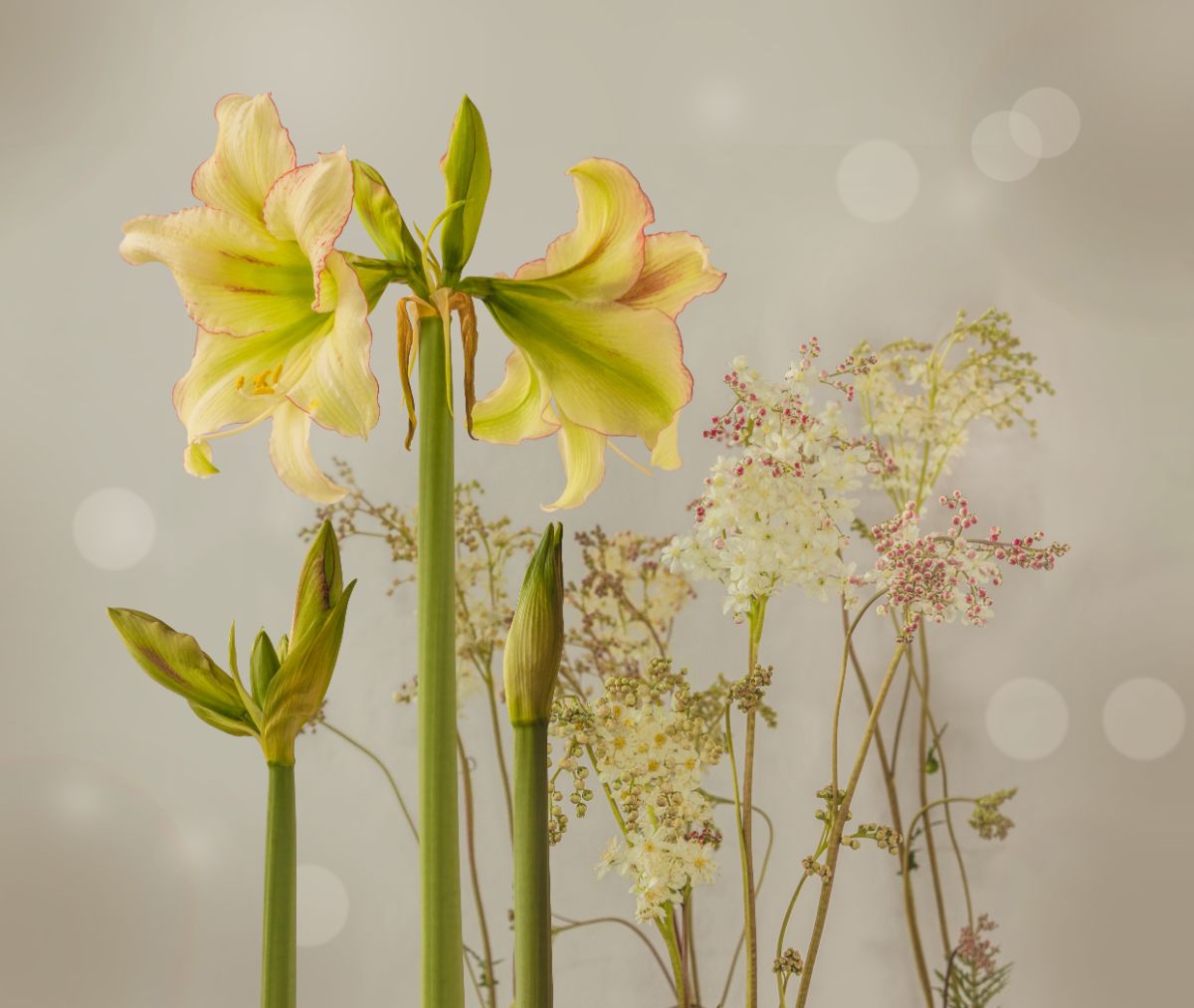
| Plant name: | ‘Yellow Star’ Amaryllis |
| Light requirements: | Bright, indirect light |
| Water requirements: | Moderate |
| Pet safe? | No |
| Notable features? | Bright flowers |
Amaryllis may be associated with the holidays, but these easygoing plants can be enjoyed throughout the year. Most often, you’ll spot amaryllis with deep red petals, but you can find amaryllis flowers in other shades, including blue, white, and pink. However, if you’re craving more yellow plants, you need to get your hands on a ‘Yellow Star’ amaryllis.
Like other amaryllis, ‘Yellow Star’ grows happily in small pots, which makes it a top pick for apartments and other small spaces. This plant is toxic to pets, though, so be sure to keep it out of the reach of your furry friends!
Summary
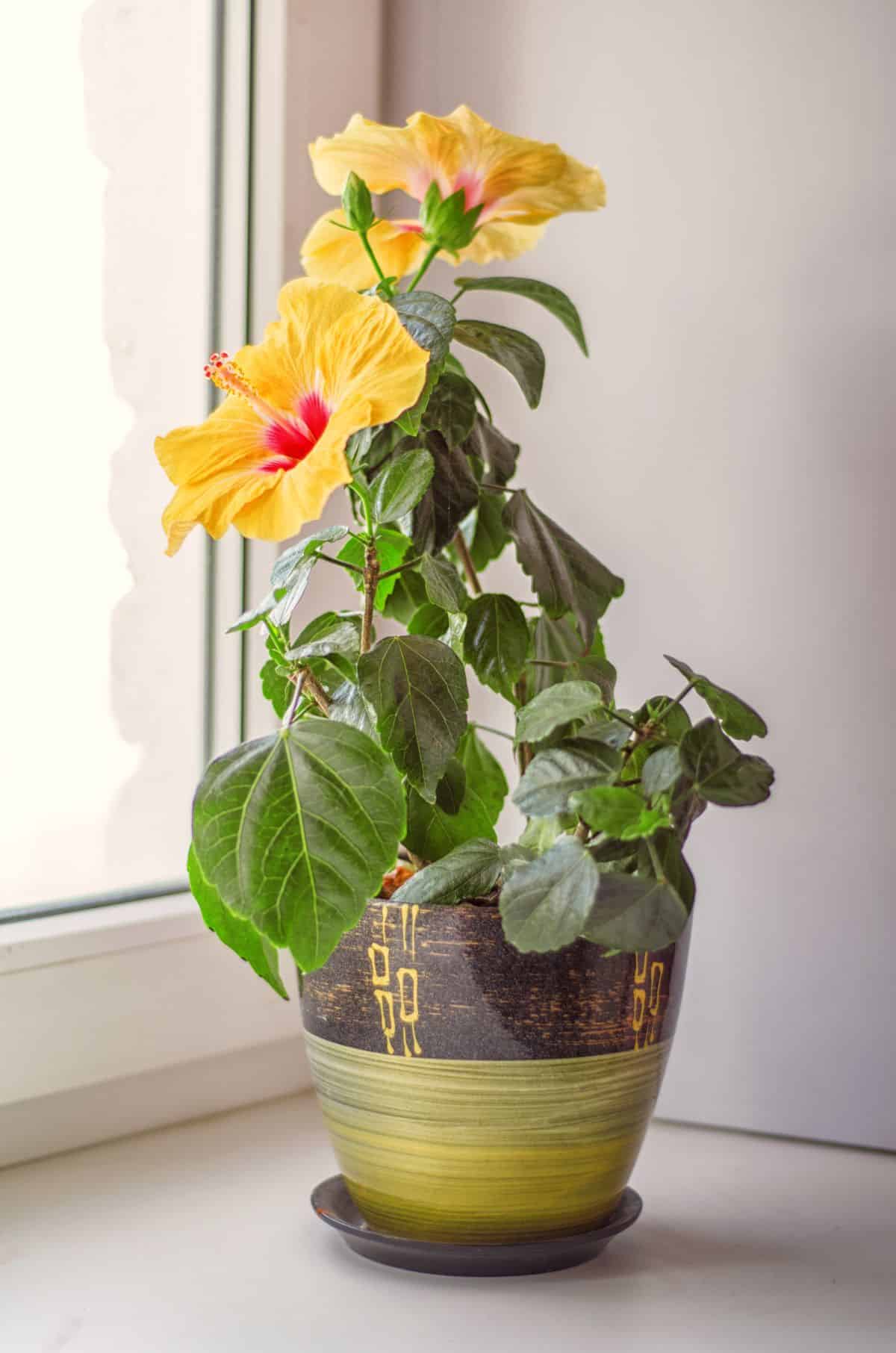
Curating a color-coordinated houseplant collection can be a fun and exciting experiment to see how many yellow-colored plants you can find. But if you’d like even more houseplant inspiration, check our list of the top easy-care indoor plants for your home. Or find pet-friendly tropical, succulent, or cactus plants in our other beginner-friendly articles!

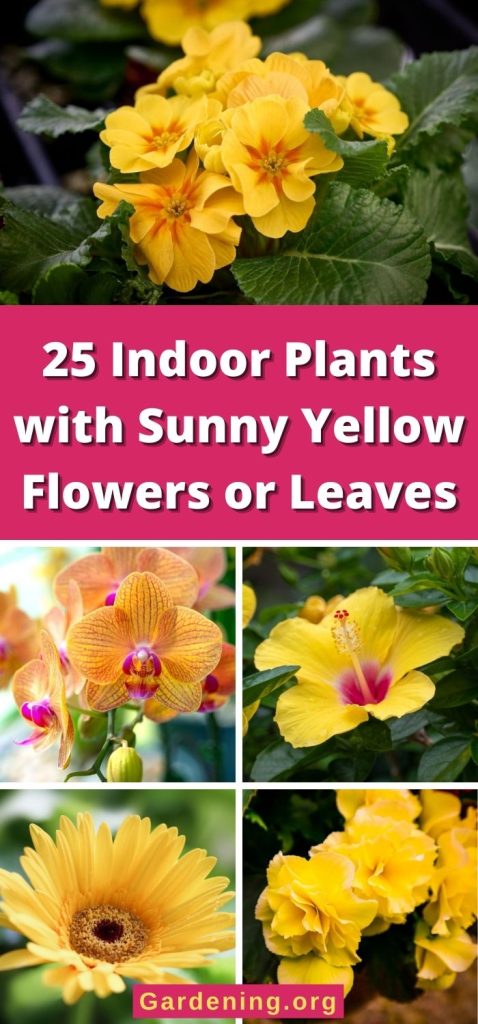
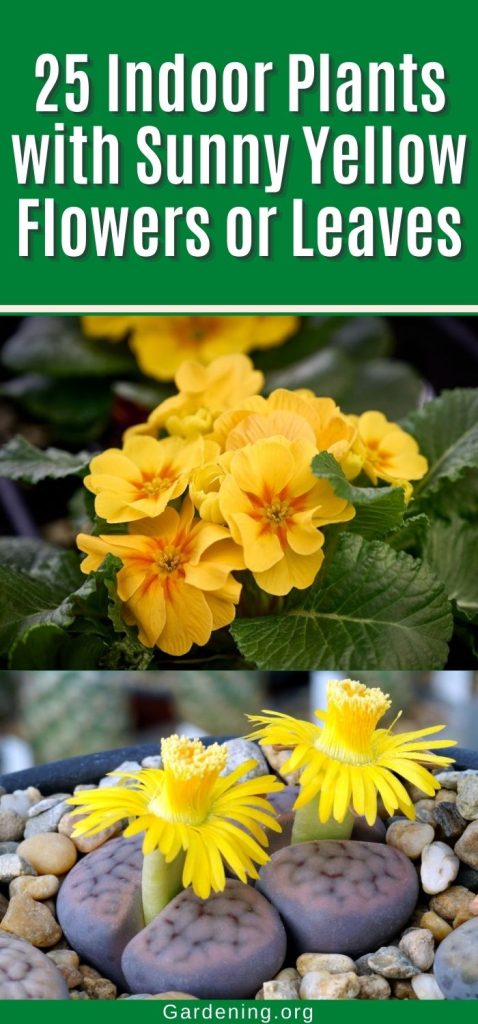
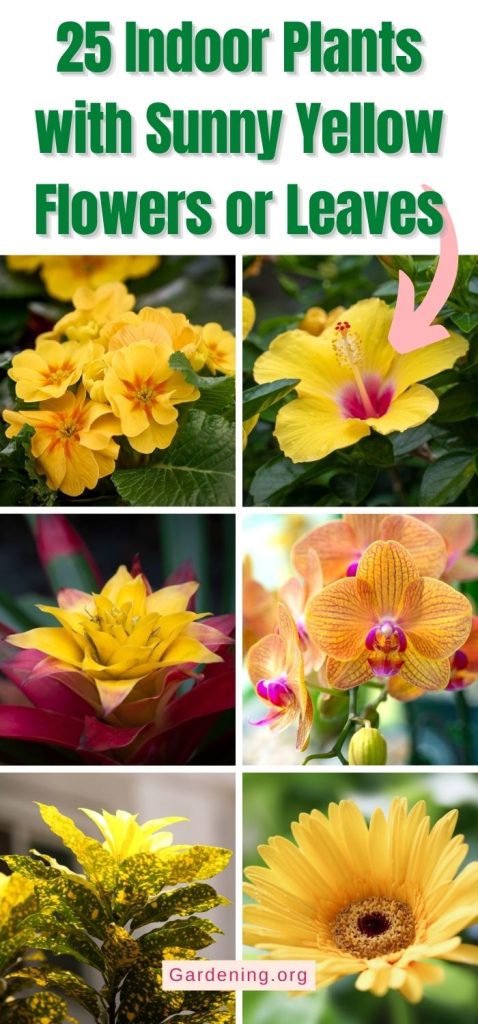
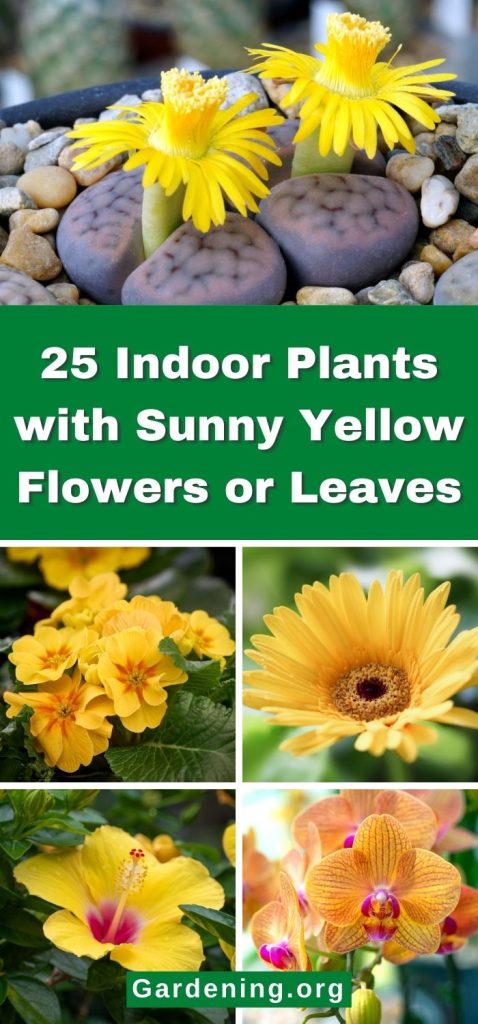
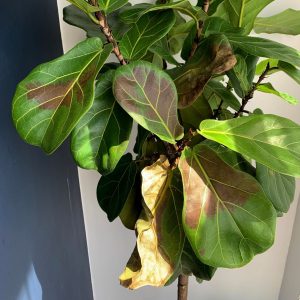
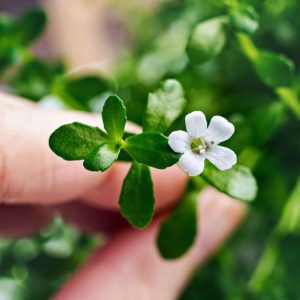
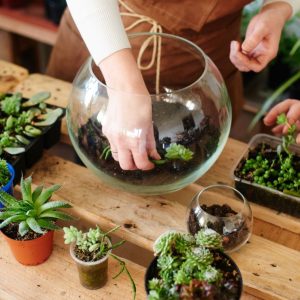
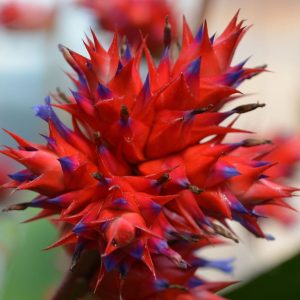
Leave a Reply